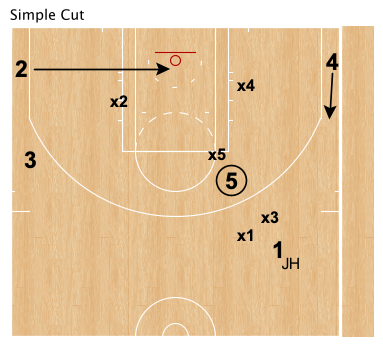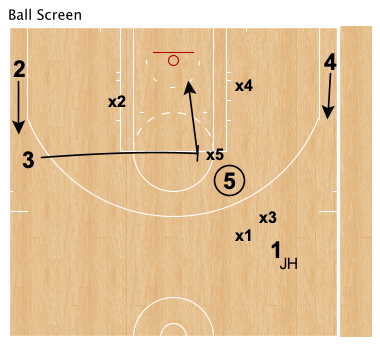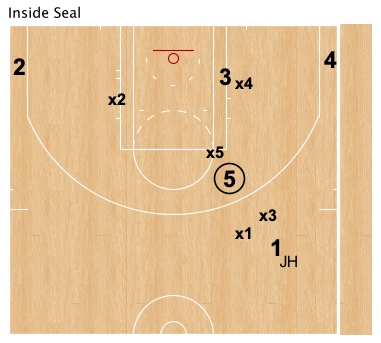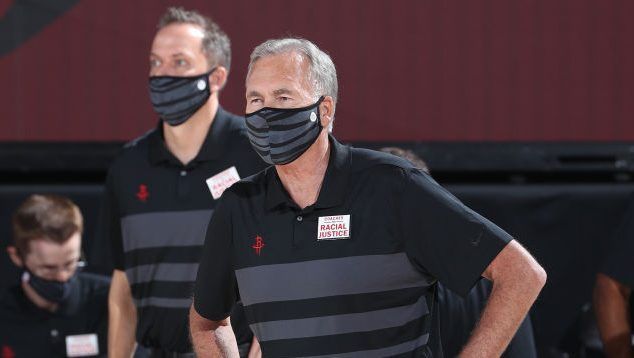
A Post Mortem on Rockets-Lakers
The Lakers have won game 5, wrapping up their Western Conference Semifinals matchup with the Rockets in a quick 5 games.
I’d like to take some time to break down a couple key concepts in this series around adjustments. While the game is about the players, the coaching in this series stuck out to me, particularly in contrast to the chess match we saw played by Boston and Toronto on days opposite the games from this series.
Today, we’ll look at how well playing big went for the Lakers, the reasons why we saw what we saw in that regard, and the two tactics LA used against Houston that weren’t effectively countered that resulted in this being such a quick series.
Since my pre-series messaging had a clear headline recommendation (“Go big”) with underlying methodology that may have been missed, I’d love to start there.
Strategy Going Big
Series evolve, and advise from one game to another might be very different based on adjustments made by the teams. This was a situation I found myself in in game 3, where my pre-series “go big” advise changed as both teams made decisions around tactics that led to it being suboptimal. But that pre-series advice continued to live in my mentions for games 3 through 5, where that pre-series advocacy that was no longer the case was missed by some, misunderstood by others, and seen as a “gotcha” by more.
As we review, let’s start by reiterating what the idea was behind playing 2-bigs (AD + McGee/Howard) lineups that I outlined in my pre-series article here. If you read that piece, you’ll understand why the theory made sense for this series and how as we saw teams adjust, or not adjust, and understand it was a strategy that stopped making sense by early game 3.
Reason 1: Offensive Rebounding
The Lakers would have an offensive rebounding advantage playing bigger. They did on the regular season playing big vs small, and that was often big vs big and small vs small lineups. A big vs small situation against Houston, a team that couldn’t go big to match, looked like a juicy opportunity.
While we did see this advantage play out, with AD + McGee lineups boasting a 33% OReb rate. That’d be the 18th best rate among the 232 2-man lineups that have played 25+ minutes together during the playoffs so far. The AD + Howard grouping got only 3 minutes in the entire series (as of post-game 4), so there’s not much of a sample to analyze there.
As a whole, I’d consider that success. This OReb rate is much higher than lineups with AD at teh 5 and Kuzma or LeBron as the 4. But the reason it hasn’t been a differentiating factor for the Lakers playing big is that for lineups with Kuz or LeBron playing PF and AD at the 5, LA actually has a 35% OReb rate.
This surprised me. On the regular season, Morris’ Real Adjusted OReb rate, which estimates his impact on the team’s ability to pull down offensive boards, our data has Morris with the team’s worst rate on the team (and an F grade). Individually he wins his matchup at an awesome rate (A- grade for his OReb Rate +/-), the fourth highest rate on the team. But he isn’t a guy doing it on enough volume and demanding enough attention from defenders to increase the team’s rate as a whole, which is where McGee (A grade) and Howard (A grade) excel.
Speaking of such, and why the bigger lineups haven’t been even more elite, has been the sandwich rebounding Houston has utilized at times. As KCP explained after game 1,
“We shoot a lot of threes and like mid-range twos and they bouncing all over the court and they pretty much sandwich rebounding our bigs,” Caldwell-Pope said. “Most of the time we only got one big in there trying to rebound and for us, like just with the guards, we’re not trying to help get some of the rebounds, help out, but we know they’re going to double team them on the glass because they are small. As guards and as other players, we gotta get in there and try to get some of the rebounds.”
And here’s what that sandwiching looked like:
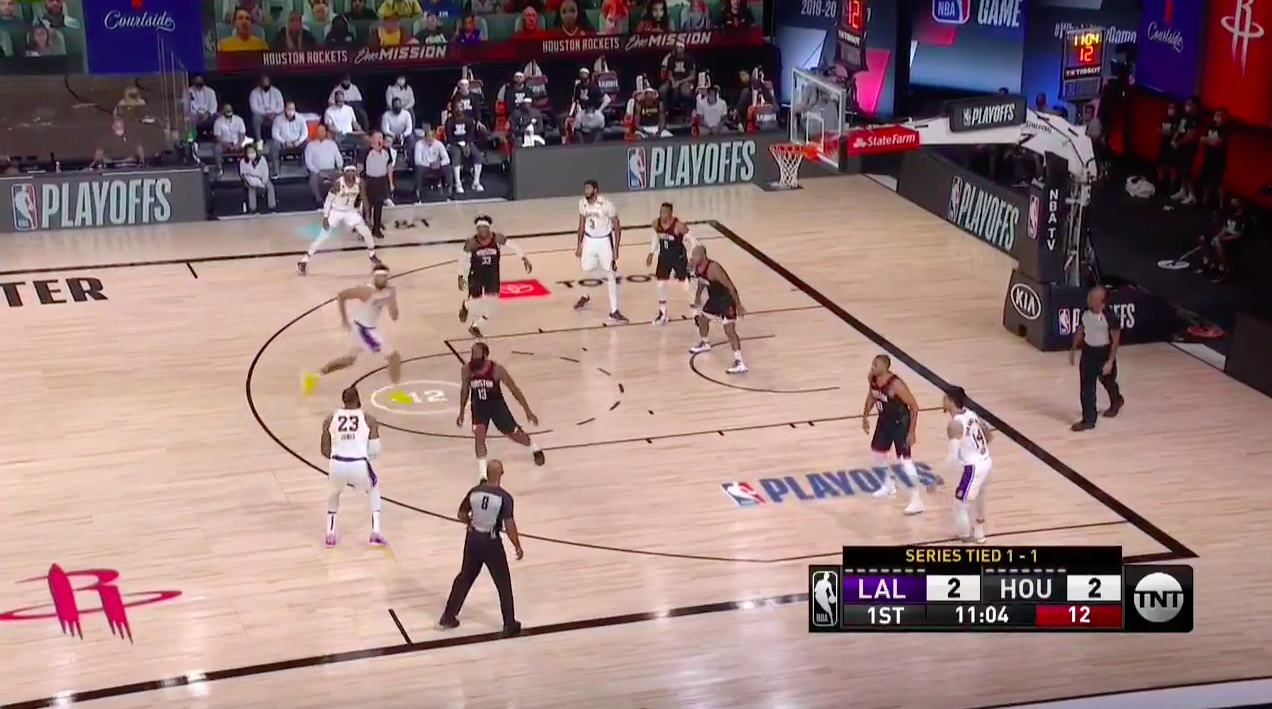
As KCP mentioned, crashing from the guards/wings whose men were the second slice of bread in the sandwich would be the counter for this approach. This didn’t happen, so we saw the LA big lineups grab only 35% of their offensive rebounding opportunities.
Contrary to that, the small lineups saw Laker players crashing from the perimeter against Houston players not boxing out, and thus performed higher relative to what we’d generally expect.
Reason 2: Offensive Spacing
While it may seem counterintuitive, the research shared pre-series (based on regular season games) and after games 1 and 2 showed that LA’s bigger lineups saw better functional spacing on isolations and post ups due to containing lob threats that forced engaged defenders. When LA went small, Houston zoned up weak side and AD/LeBron saw extra defense on those looks.
Watch how the weak side help doesn’t come on this play:
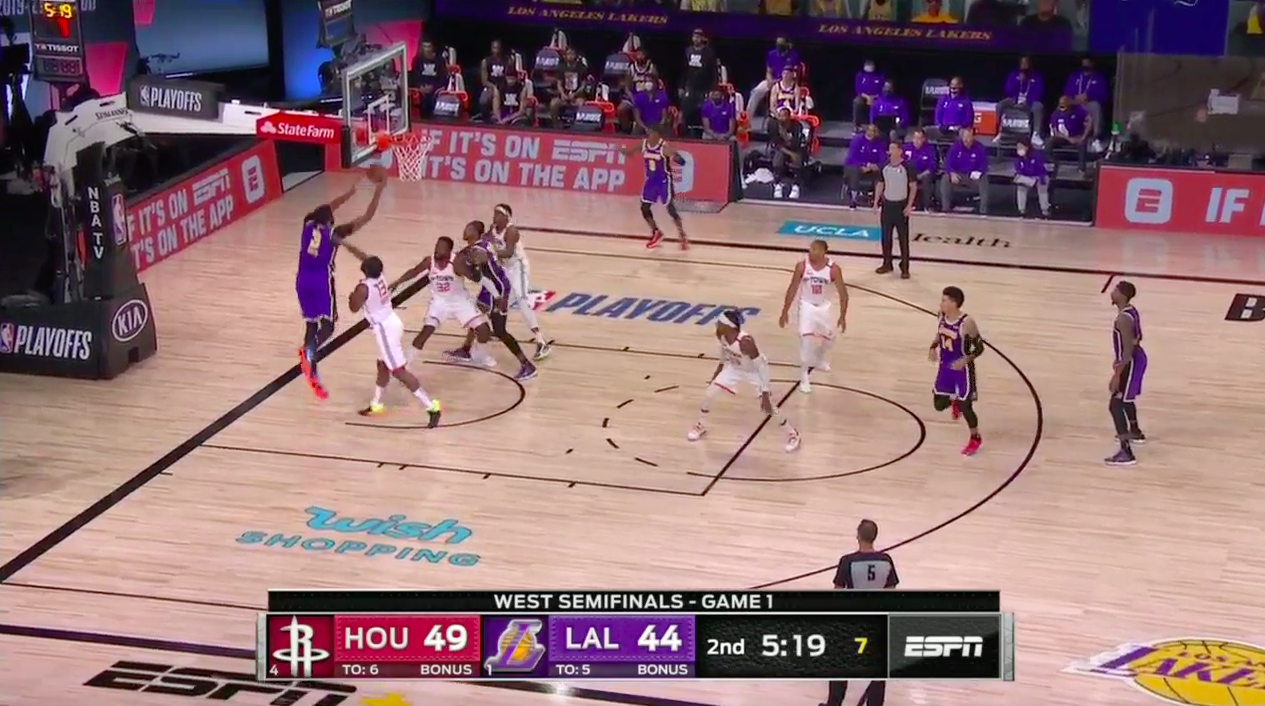
But as the series progressed, this was less and less the case. Why? Because Houston realized that the Lakers wouldn’t pass to their lob threats. The Lakers have had a ton of opportunities, but LeBron hasn’t been making those passes.
Here's another lob that wasn't thrown by LeBron. When Howard/McGee/AD are on the lane line like Dwight is on this play, the second Green oversteps it's an easy lob. pic.twitter.com/AIdzPycSxl
— Cranjis McBasketball (@Tim_NBA) September 6, 2020
And it’s important to understand how much of a height advantage the Lakers have. Rajon Rondo, who has been the one player with at least some consistently throwing to the lob threats, shows how open these lobs truly are with plays like these.
After missing passes on all 3 of Kuz on the "ghost" pop, AD with deep post position, then AD sealing his man, Rondo throws up a 50/50 ball AD out jumps multiple Rockets' players for.
Look at the lack of inside positioning + traffic.
This speaks to how open these lobs truly are. pic.twitter.com/d6Sh4erG7n
— Cranjis McBasketball (@Tim_NBA) September 5, 2020
But Rondo wasn’t playing in those AD + McGee lineups, so those groupings continued to fight uphill and not take advantage of what was available.
We saw this same situation play out with ball screens, with small lineups usually having extra help in the paint to tag LA’s slipping bigs and zoning up of shooters while the big lineups didn’t get the extra help without giving up lob opportunities.
Even so, AD + McGee lineups had a 109 ORtg and the tiny sample AD + Howard lineups had a 120 ORtg. Morris + AD groupings saw a 111 ORtg, just slightly better. As a whole, not too shabby. But there was still a ton of opportunity there to be dominant that wasn’t being taken.
Reason 3: Rim Protection
The third, and most key, edge that I theorized going big would help LA would be to add rim protection. Since Houston is usually so purposeful around positioning opposing teams’ bigs in positions they can’t help at the rim (on-ball/top of key/strong side corner), having just McGee/Howard/AD on the court has led to more penetration and higher efficiency for Harden and Houston. This was covered pre-series, and it played out and was covered in my post-game reports.
I want to be clear about something. The idea was never that McGee/Howard can stay in front of Harden. They can’t. And thus we were prepared to deal with that, while using the length of these bigs to be better able to contest perimeter 3-point attempts from Harden.
Here was the plan for rotating on drives, as we covered pre-series:
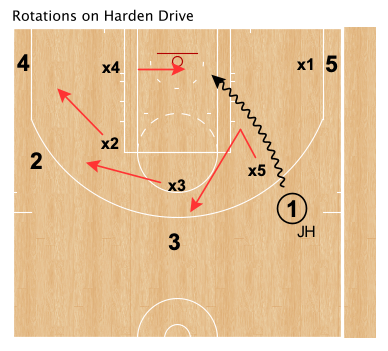
These rotations let rim protection be in place, and the big lineups let that 2nd big be in position to be that rim protection (which would be better than Rondo, or even LeBron) by using off-ball switching (we LA used).
And we saw LA use this in game 1. Here, it lets LeBron play up on Harden to play for his step back, then the easy rotations for teammates allow McGee to be in legal guarding position and 4 pass out options to be covered by 4 Laker defenders, taking away FTs from fouls, easy shots at the rim, and also open 3s on kickouts. Harden needing to settle for floaters or contested shots at the rim is what we want.
This is what I'd like Harden isolation drives to need to look like against big Laker lineups.
A 7-footer the lowest man and needs to only take 3 steps to be in a position to contest vertically.
When Harden jumps we have 4 Lakers on 4 Rockets off-ball and only 1 guy on-ball. pic.twitter.com/SdaMLMmu1O
— Cranjis McBasketball (@Tim_NBA) September 5, 2020
This wasn’t just a single possession thing. As I covered in my post-game 2 report, we saw Houston shoot far worse at the rim against LA’s big lineups, get far fewer open 3s, and score less efficiently. The process (shot profile) and results were there.
In game 2, we did see LA tweak this to take advantage of Houston not trying to make passes to the top of key player. As long as the corner and wing Rocket players were covered and couldn’t make the quick “one more” pass, keeping the driver’s man on the driver allowed extra back pressure to contest both passes and shots.
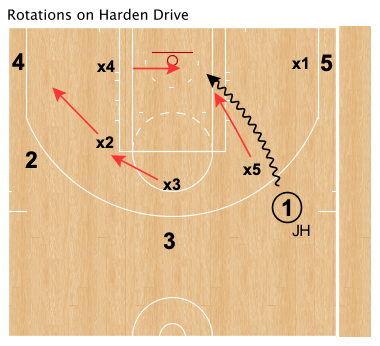
Here’s what that looked like in game 2. If Harden, and Houston’s other ball handlers, won’t make that behind the head tough angle pass, this just improves the defense without giving up much in terms of risk.
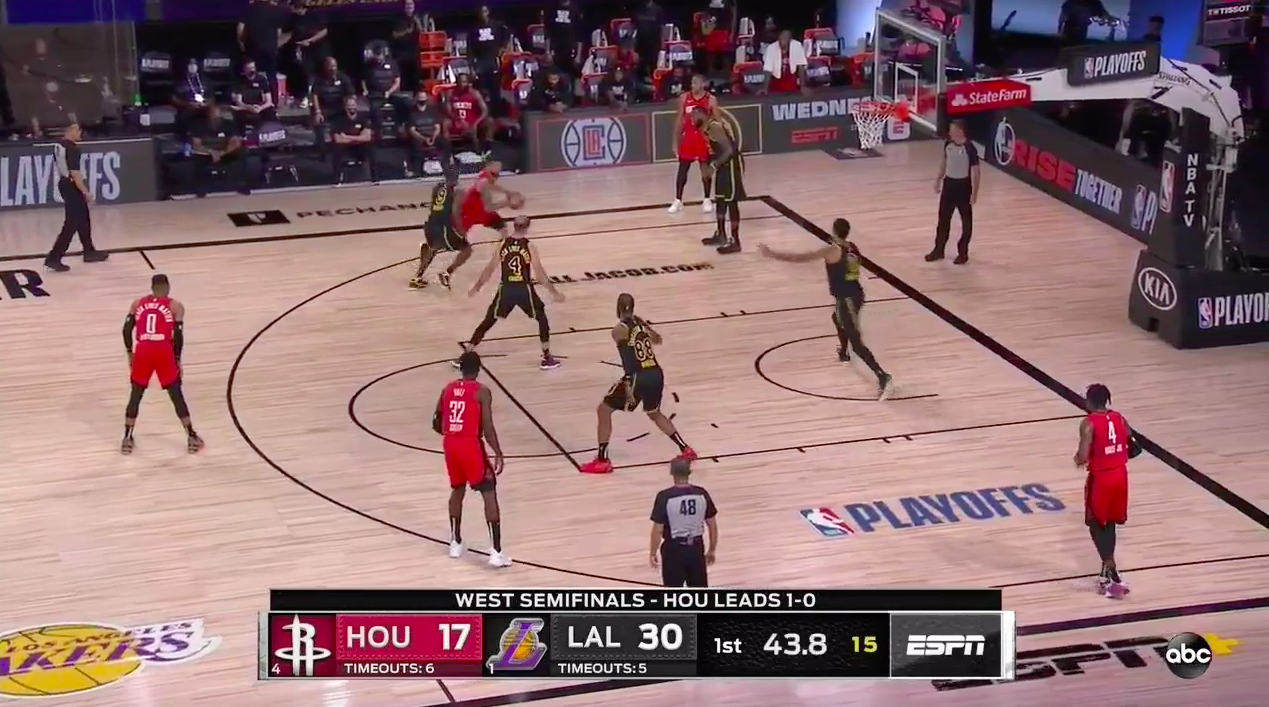
This strategy worked, as we’ve covered. But Houston did make a simple adjustment in game 3 that made a huge difference.
And when LA played without 2 bigs on the court, we saw possessions like this all series against LA’s man defense (when they weren’t trapping):
This is too easy for Harden. Because Howard is the only rim protector on the court, him strong side corner negates all of LA's rim protection.
If Caruso leaves early enough for this to be a charge that's a kick out to the corner and a quick pass to Gordon for an open 3-pointer. pic.twitter.com/aDjlsfEu3S
— Cranjis McBasketball (@Tim_NBA) September 6, 2020
Houston’s Adjustment
Here was the simple, yet effective, counter from Houston.
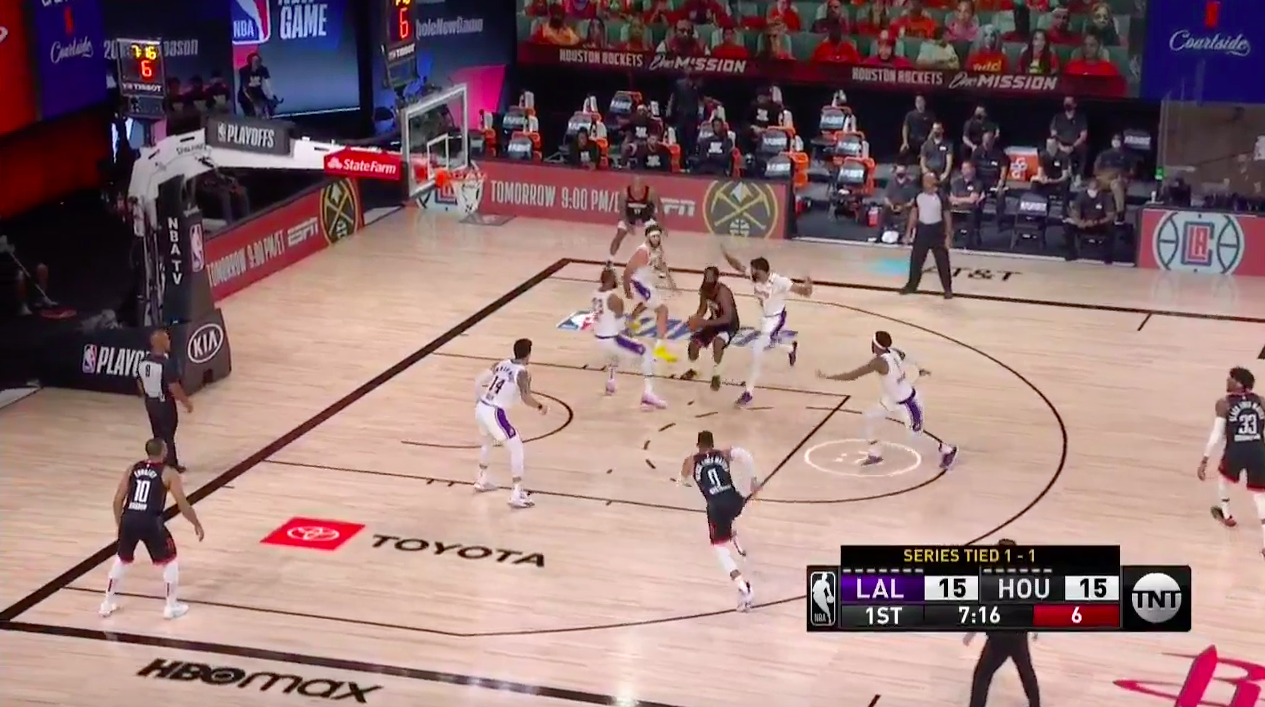
Here’s a diagram of what’s happening. LA was rotating to zones, rather than players, which made cuts from the opposite corner or wing lead to a Laker defender guarding no one and an easy dump off option for Harden.
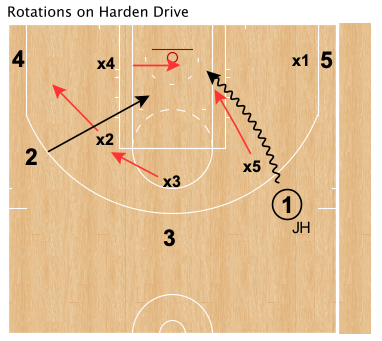
This led to some scoring and some good shots that didn’t lead to scores. An effective counter, but nothing impossible to adjust to from the Lakers. All it takes is that defender playing that same man, rather than blindly playing that zone, to be able to either rotate as we covered before or cut off that cut, as we see below:
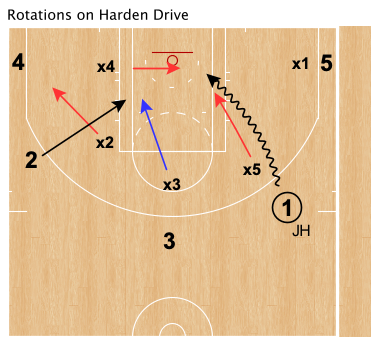
Instead of doing so, LA moved away from playing big altogether after this stint.
Up to that point, even including that high efficiency from Houston on a couple minutes, LA’s big lineups were outperforming LA’s small lineups playing straight up (or using this strategy). If LA didn’t make the simple adjustment, that gap would narrow due to this adjustment from Houston.
Along with the lack of an OReb edge and offensive spacing (and lack of lobs being taken advantage of), early in game 3 it became clear to me that while going big had potential to dominate and was a far superior option to playing the same strategy going small, LA’s use of 3-2 zone and double teaming made going small the right approach as long as Houston didn’t make simple counters to those tactics (which we’ll cover soon).
Ironically, the adjustment HOU made in game 3 that led to this outpouring of points by cutting was the right idea for how to attack the 3-2 zone as well as be one solution to their issues attacking double teams.
It took more than a paragraph or two, but I hope that explains thoroughly why going big was a smart strategy we saw LA implement with success on both ends for 2 games but to increasingly less of an edge than playing small, due to a lack of adjustments from LA and an uncountered adjustment from Houston.
Now let’s talk about Houston
This series has been fairly one-sided for a number of reasons. Houston is overmatched from a talent standpoint. But they have been all season, but have used a smart system offensively to make the most out of players with limited skill sets.
And when you play Houston in the regular season, you usually pick from a number of options for how to defend them. Teams try a lot of options, and we see that on film with Houston facing tons of varying ball screen coverages and in the data showing how often teams play zone against this offense.
But LA took two approaches that solved some of their defensive weaknesses that Houston’s offense attacks, fit their personnel well, and flat out weren’t adjusted to.
Double Teams
As we covered pre-series, double teams that were passive and let Harden take his time and find the open man were far less effective than doubling hard and trying to pressure both Harden and the short-roll man. The Lakers figured this out more as the series went along, and we saw LA’s percentage of hard double teams rise relative to the softer ones, and Houston’s efficiency when double teamed drop accordingly.
Here’s the situation Houston has found themselves in, time after time.
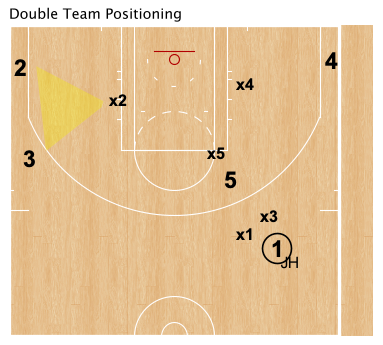
James Harden (1 in the diagram) has the ball, with two defenders on him. He has a pass to a player in front of him or sometimes at the top of the key, who either has a defender on them or rotating to them. LA then has 2 players defending 3 Rockets.
4 on 3 situations should be efficient. But when Houston has a roster dense with players unable to attack the rim effectively, playmake at above average levels, unwilling to shoot from mid range, or even shoot too well from the perimeter when not open, Houston has problems.
Just like with the proposed “go big” strategy, the parts of this that worked were to prevent FTs foul trouble, and shots at the rim, and make rotations to prevent open 3s fairly easy as long as Houston decided to just stand around when these traps happened.
And that’s exactly what Houston has done, turning a smart but beatable opening move from LA look like genius adjusting. But since we haven’t seen Houston play any chess, and the series is now over, let’s take a look at some of the quite simple adjustments that were well within Houston’s capabilities from a personnel standpoint and would’ve forced LA to adjust away from their double teaming.
Let’s talk about 5 simple approaches Houston could’ve taken to counter LA’s double teaming.
Options 1 & 2: Cut
Just like with Houston’s adjustment to LA’s big man rotations (which were the same when going small, just on small volume due to the doubling and 3-2 zone usage), a simple cut can cause problems for LA’s defense.
Standing still and allowing a single Laker defender to successfully guard two shooters long enough for the defense to recover is poor offense. This solves that, by taking those two offensive players and moving them away from each other. Not with one running towards half court, as we often see Houston do. That makes one player more open, but in a non-scoring position.
Instead, we make x2 have to make a decision. Would he rather give up an open 3-point attempt or a shot at the rim.
Here’s another options also only consisting of a simple cut. Player 3 and 5 get to the elbows and look for the pass from Harden. Whichever one doesn’t get the pass then cuts to the rim.
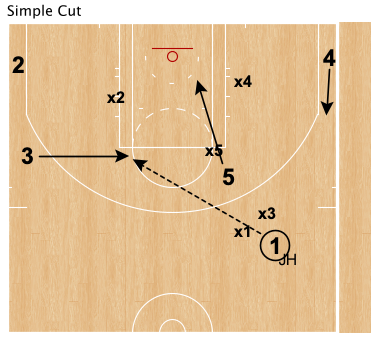
This doesn’t need to be hard. And it’s well within what Houston can do, because we’ve seen them literally do it in these same games.
Option 3: Off-Ball Screen
In high school we used to play a game at practice where teams competed in temporary 4 on 3 situations with the 4th defender needing to sprint into the play from half court, helping the offense fine tune how to attack a temporarily short-handed defense.
I broke that game, by setting pin-in flares for teammates, where I either screened or posted up a defender that was attempting to defend two offensive players weak-side. My coaches literally banned me from doing this after a week or two, because it became evident that the defense couldn’t stop it.
This is literally exactly what Houston can do in this 4 on 3 scenario, and is something they utilized regularly against defenses that try to sag in and show early help against Harden Drives.
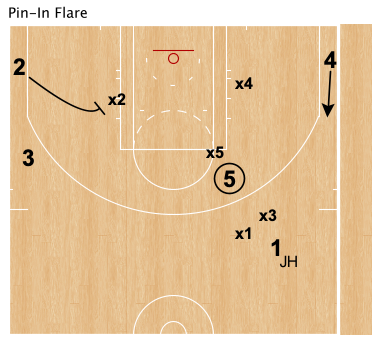
By 2 setting that screen on x2, player 3 can catch and shoot an open 3-pointer without even needing to move to get open while x2 isn’t able to recover and contest.
Again, this is a simple adjustment to do something playing to Houston’s strengths and pre-existing tendencies.
Option 4: Ball Screen
Why do teams use “ram” action ball screens, where the eventual ball screener first receives a screen from a teammate to free them up? Because without the screener’s man being in position, a ball screen creates a 2 on 1 situation that’ll almost certainly lead to a good shot.
Let’s use that same principle here. Easy to teach and implement, you’ll end up wanting player 3 to be cutting towards x5 to set that ball screen as soon as he gets the ball. But (in just 1 diagram) here’s what it’d look like:
That 2v1 situation created would yield some good offense and good offense quickly. If you screw the timing up, it won’t work. But be on the same page, as teams need to be for all plays, and it should work pretty well.
Option 5: Inside Seal
Another option Houston can pursue would be to do something they don’t do often: use a post player.
We don’t need any fancy post moves, though. All we need the player to do is set up on the block and get inside position on x4, who ends up guarding a corner 3-point shooter strong side and that inside player. Because it’s strong side, it makes the read far easier for the player getting the ball at the elbow. Either get the 3-point look or lob that ball inside.
Hell, you can even have that guy stand directly under the rim the second the ball gets to player 5. Stand your three offensive players in the highest value offensive spots on the court while stretching those two defenders as far as they can realistically be while still having your offensive players be in scoring positions.
Easy money. 4 on 3 situations should be easy money. It’s damning to your coaching staff if they’re not, despite you constantly getting them. None of these are elite adjustments or require personnel any different from what Houston has. None of it requires difficult decision making. These were just 5 simple answers off the top of my head, but Houston could’ve done more to counter what LA was doing with their double teaming.
Again, LA made a smart move by going with these double teams. They showed continued intelligence by switching to harder doubles on Harden instead of soft ones. But this should’ve been check, not checkmate. Houston let themselves, and Xs and Os nerds like me, down by not making any of these adjustments with any consistency.
And not for a quarter. Not for a half. Not even for a full game, which would still be bad. But for an entire series, with the doubles starting in game 1. That’s wild to me, and I hope you can now also see how poor that is.
3-2 Zone
The other adjustment LA made, which was also smart but beatable, was to play a 3-2 zone. Before we dig into what Houston could’ve done, let’s outline why this was smart from LA:
- It kept LA’s bigs on the back line, where they couldn’t be brought into ball screens and switched onto Harden on the perimeter. And it keeps them in position to rotate and provide rim protection. A nice 2 for 1.
- Unlike a 2-3 zone, or several others LA could’ve used, a 3-2 zone isn’t one you can line up 5-out against and just shoot open 3s over it. It’s naturally a good alignment to how Houston likes to align, which means Houston would have to use smarter alignments, screening, or cutting to create scoring opportunities
- It creates a natural wall at the top of the key, presenting Houston with a barrier difficult to drive through if they chose to just try to drive on the zone (they tried).
- Houston’s no mid range principles naturally play into Houston not attacking the zone in some of its weakest points
3-2 zones also aren’t seen used much for a reason. They’re quite beatable. Not even college teams use this method of zone much at all. And Houston had no clue how to attack the 3-2 zone when they first saw it in game 2, where they decided to try to drive through the strength of the zone (the top of it) through multiple defenders, leading to tons of inefficient possessions and turnovers.
But then Houston talked some big game before game 3. And I assumed (and tweeted about it) they had dusted off some old high school plays or googled how to beat a 3-2 zone and had answers. Then I was stunned, because they didn’t.
Again, Houston attacked the 3-2 zone with either no plan or only a vague idea of how to attack it. So let’s cover 5 ways Houston could’ve attacked the zone with more success.
Option 1: Pick your Matchup
Wait, but wasn’t one of the benefits of the 3-2 zone that LA could hide their poor perimeter defenders? Yeah. But they’re hiding in a zone on the court, not behind a brick wall. Just take your isolation to them. No ball screen needed.
Here’s a look at what that might look like. If Morris is on the back line as x5, send Harden to the corner to isolate from there.
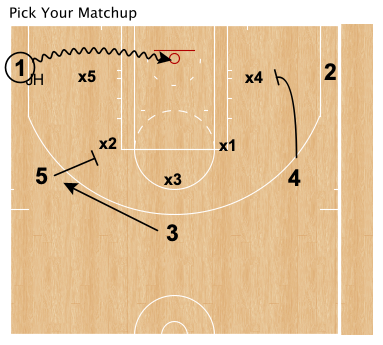
Pair that with some off-ball screening and you’re covered if LA tries to double from teh tope or send help from the opposite back line big.
Even without those screens, Houston can create the same dribble penetration into a scramble situation they do in their normal offense to generate shots at the rim and open 3s.
Option 2: Use the High & Low Post
Houston doesn’t like putting players at the high or low posts, so this would be fairly radical for them but also pretty simple. Overload the zone by using the high and low post, with those players following the ball.
Here’s a video that outlines an approach similar to what I’ve used in the past at the high school level and seen college teams use to beat a 3-2 zone.
Get the ball to the high post on the overloaded side and you have a drive, dump off, or pass to a 3-point shooter.
Option 3: Overload the Corner
Another way to overload against a 3-2 zone is to send a cutter to the perimeter after that zone’s defender is on-ball.
Here’s a very simple iteration of the many Houston could use to accomplish this:
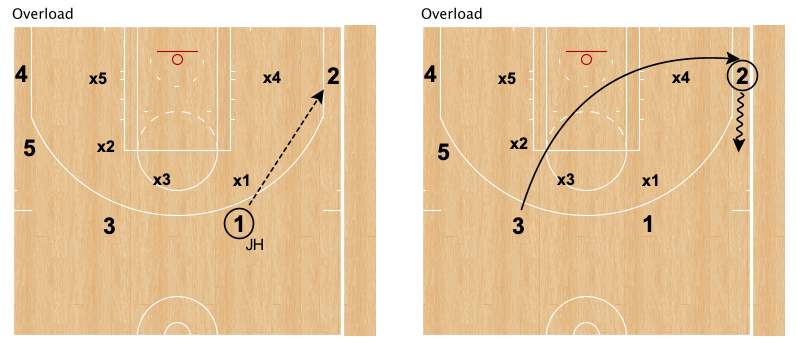
I’ve seen plays where you even do this a second time. If the defense decides to abort the zone and play man, which we saw LA do a couple times when the ball went to the corner, you’ve solved your problem and can attack the way you normally would. If not, you may get a wide open shot (if that initial cut isn’t open).
Option 4: Overload with Ball Screens
Another method of creating advantageous situations for the offense is to use a ball screen simultaneously while overloading the zone.
Here, having 5 slip towards the rim as 1 would dribble off the ball screen toward the right side while 4 runs baseline and 2 lifts from the corner to the wing would create a tough situation for the defense.
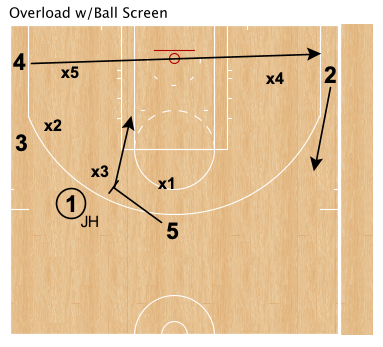
Option 5: Invert Your Numbers
Another natural way to attack zones is by aligning in ways opposing their alignment. Against a 2-3, have a 3-2 or 5-out or 1-3-1 alignment. Against a 3-2, align 2-3 (or 1-3-1 can also work). Here we’ll look at an example of what getting into a 2-3 offensive alignment can look like.
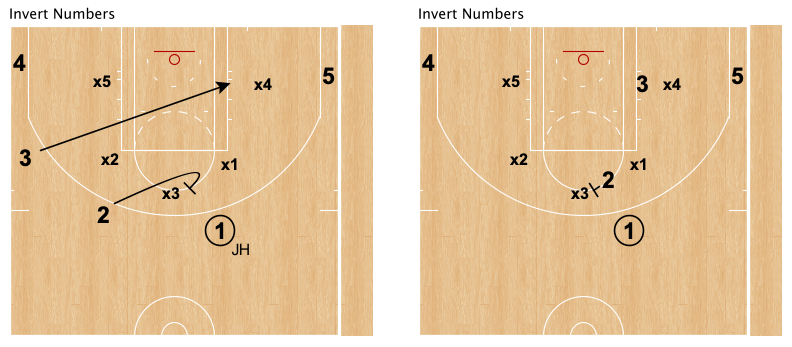
With an attack like that, your two back line defenders are defending three offensive players and the ball screen keeps x1 from going to help that back line.
These are just a few of many options Houston may have had. I didn’t even touch on several principles they could pursue, such as pinning-in for shooters, sealing inside, and a few others. And even if you’re weaker with attacking zones schematically, just phoning a friend or doing some googling can find some quick, acceptable answers.
Wrap Up
As I spoke about on a recent podcast here, this was an uncomfortable series for me as a Lakers fan. I knew that what LA did with their trapping and zone were very beatable, and if Houston adjusted it’d put the games back on a more level playing field at best, and tilting towards Houston until LA pulled another trick out of their bag.
And that bag, at least from my perspective, didn’t have many tricks left. A 2-3 zone, 1-3-1, box and 1, triangle and 2, and a couple less recognized zones I’m aware of all fit far less naturally against Houston’s scheme and personnel than a 3-2. And if you can’t double and need to play man, we’ve seen Houston shred the Laker defense. If the Rockets continued scoring as efficiently as they have against LA’s smaller ball man defense instead of facing traps or 3-2, this series would have different results for a few games. That was worrisome to me, as I was expecting adjustments to come from Houston.
They just didn’t.
For LA, instead of adjusting to what Houston threw at them, they were able to just completely change the situation by aborting playing big altogether. That was a type of luxury Houston didn’t have, but it also doesn’t bode well for future rounds for LA. Running away from potential adjustments works sometimes, but against Boston/Miami it’s likely not going to be an escape route.
My original series prediction, Lakers in 5, ended up materializing. But it didn’t happen how I was expecting. After game 1, once LA decided to commit to playing small, and before Houston found a way to effectively counter LA playing big, I tweeted out it could be Houston in 5 if LA didn’t adjust, and if LA did adjust it’d be Lakers in 6.
And boy did we get that. LA adjusted by going to a zone and throwing a horde of double teaming at Houston on higher volume, but I wasn’t anticipating Houston not having any answers for those tactics. So by that in-series prediction, LA ended up exceeding my expectations (and it had more to do with Houston not adjusting).

